Updated: 23-Nov-2021
This company was founded by Arturo Elizalde Rouvier in Barcelona in 1908 for the construction of high quality automobiles.

"Arturo Elizalde"
-He began manufacturing car parts and spare parts, building his own automobile around 1912. (Vallet y Cia.).
-The first series was released in 1914 with the name "Biada-Elizalde". Carmen Biada was his wife, with a strong personality and who formed a great team with her husband. Upon his death, in 1925, she continued to run the company for another 24 years.
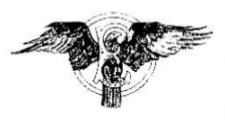
"Logo Elizalde"
-Elizalde continued the construction of high quality cars and in 1917 they launched the first aviation engines.
-For the yearning people of this important Spanish factory, we show the old factory in Paseo de San Juan, in the center of the city of Barcelona. At the front we can see the "chalet" with the offices. And in the lower picture we can see how the site of the disappeared factory looks like today, with apartment buildings.


"Elizalde factory and the same site today"
-The first aviation engines were the T-41 and the T-80. The former one with inline cylinders giving 100 CV, was air cooled, and it had steel sleeves and aluminum cast fins on the cylinders.
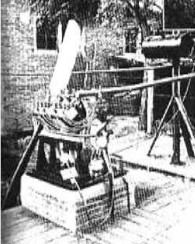
"T-80 tests"
-We can see the bench tests of the T-80. It was a water-cooled V-8 giving 150 CV at 2,000 rpm.
-At the end of WWI and with so much surplus material, it was more affordable to obtain engines abroad, and this finished off these two engines that had already been tested successfully.
-Elizalde continued to build automobiles until 1925 when it was required by the Military Aviation to dedicate itself entirely to the manufacture of aviation engines.
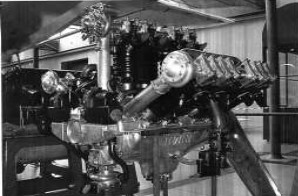
"Elizalde-Lorraine at the Terrassa museum"
-First they obtained the manufacturing license for the French Lorraine W-engine, the 12 Eb that gave 450 CV to equip the Breguet XIX that was built by CASA.
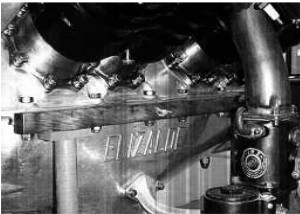
“Elizalde name on engine block”
-We see in detail the Elizalde brand name in relief on the Lorraine oil pan. On the right we also see the IRZ carburetor manufactured in Valladolid, Spain. And we can see the quality of construction in general as well.
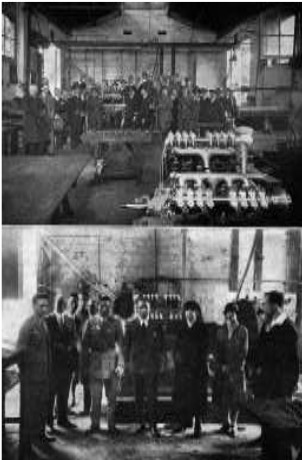
"View of the Elizalde workshops and Carmen Biada"
-In the view of the assembly workshops we see a Lorraine 12 Eb. And in the second photograph Carmen Biada attending a military commission.
-The Lorraine engine was known as "A-3" and was tested on March 8, 1926. By December of the same year, 55 engines had been delivered and 369 between 1926 and 1929.
-After modifying the valve system it was renamed "A-4", and it was also applied to the previous "A-3" engines.
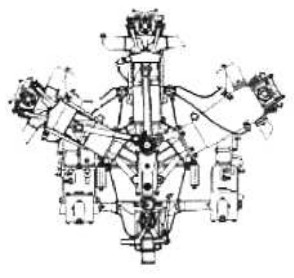
"Elizalde A-3"
-The "A-5" with gear was a 12-cylinder W-engine that gave 480 CV at 1,850 rpm. It was water cooled.
-The "A-6" was a small air-cooled radial engine, created in 1929, giving 120 CV with 5 cylinders. This engine was designed for small planes, and it was mounted on the CASA III and Loring E.II.

“Dragón IX”
-The first "Dragon" was born in 1929 and was the D-IX with novelties such as floating bearings in connecting rod small and big ends, and the application of an old Elizalde patent to use bronze cylinder heads and valve seats.
-It was the winner of a contest organized by the Superior Council of Aeronautics, and the only one that obtained the official approval. It was a 9-cylinder, air-cooled radial engine giving 420 CV and weighing 340 Kgs. The compression was low, from 5'5 to 1.

"At the París Air Show"
-At the 1932 Paris Air Show, Elizalde's engine factory presented its radial "Dragon" engine series.
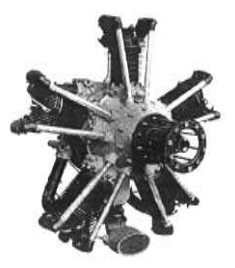
"Dragón V"
-The "Dragon-V" gave 165/172 CV and together with the "Dragon-VII" it was destined to school and tourism airplanes. It had five cylinders and an IRZ carburetor, and two Scintilla magnetos.
-The "Dragon-V" was similar to the British Mongoose that gave 172 CV at 1,900 rpm and was a 5-cylinder radial as well.
-The "Dragon-VII" (or D-7 sometimes), was a seven-cylinder radial that gave 320 CV at 1,800 rpm.
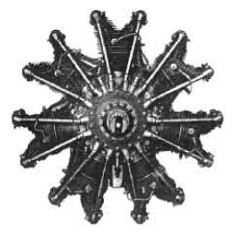
"Dragón-VII"
-The mentioned "Dragon-IX", with the said 420 CV up to 470 CV, and also the similar "Super-Dragon" with 9 cylinders giving 525 CV.

"Super-Dragón"
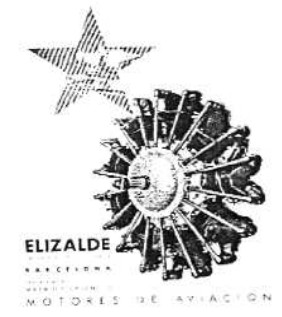
"Elizalde Dragon IX brochure"
-By 1935 Elizalde acquires the license of the Czechoslovak "Walter" and they begin to mount them on the AISA GP-1 (GilPazó-1) light aircraft.
-The engine was known as "J-4" and gave 105 CV with 4 inverted, air-cooled cylinders. (see Walter).
-In 1935, Elizalde also obtained the license to manufacture American Pratt & Whitney engines, which were not built because of the civil war.
-During this war and due to its potential activity, the factory was bombarded from the sea by the cruiser "Canary Islands" as it was said to avoid international conflicts, but in reality it was the Italian "Eugenio de Savoia". On February 13, 1937.
-With the factory being located almost in the center of Barcelona (between the streets Rosellón, Paseo de San Juan, Corsica and Bailén) the surrounding suffered the consequences.
-After the war, begins what could be called the second period: the Barcelona factory at Paseo de San Juan was intervened and attached to the Ministry of Air.
-In 1940, it resumes its industrial works with a mass construction of a 9-cylinder engine derived from the "Super Dragon" from 1936. It received the name "Beta" and the official name was "9.EC.29-750".

"Beta"
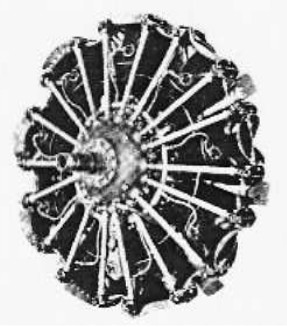
"Beta"
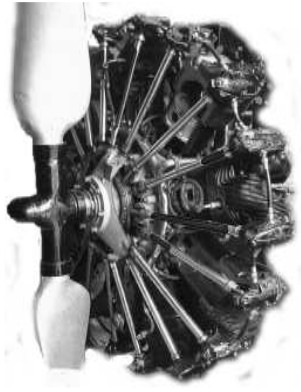
"Beta cutaway"
Author's note: The remains of a Beta engine opened by the crankcase could be seen at the Miguel Creus Aeronautical Library -L'Aeroteca- , showing the crankshaft and connecting rod system, some piston and cylinder 1, very didactic.
-Today is deposited at the Interpretation Center of the Historical Memory of the La Sénia Aerodrome.
-The last Beta that appears on this page belongs to the aviation engine collection of Mr. Castellseguer in Mataró, Barcelona. It has the propeller from the Ju-52 CASA, manufactured in Spain.
-Later with an accurate vision of national needs, Elizalde approached the "Tigre" engine project.
-The 125 CV G-IVA and the 50 CV G-IVB were manufactured. In aerobatic flight versions a "TM" carburetor (Engine Technique) was used for inverted flight and height corrector, (instead of the Standard "IRZ"). It also had oil recovery pumps of several bodies for oil collection in all positions. This was the G-IVA5 engine.

"G-IV with IRZ"
-We can see the acrobatic version with oil ducts to the collection pumps (rear upper part). There were versions with air filter and alternative hot air intake.
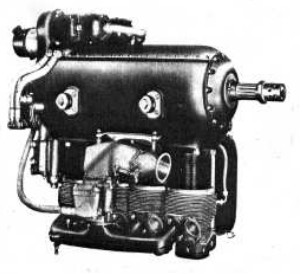
"G-IVA-5 with TM"
-The power difference between A and B was due to the compression ratio, from 6 to 1 in the former and from 6'5 to 1 in the latter because the 125 CV were achieved at 2,200 rpm with the A, and the 150 CV at 2,500 rpm with the B. We have seen the A installed on the CASA Bücker Jungmeister and the B on the Aisa I-115.
-The "Tigre" engine project was mainly due to engineer Huarte Mendicoa, supported by an important team of engineers (Medialdea, Alcalá, Mir, etc).
-Later Medialdea would found a subsidiary accessory company, where the TM carburetors came from (Engine Technique).
-In 1943, the "Tigre G-IV" got the authorization of the INTA (National Institute of Aeronautical Technique and later INTAET, by Esteban Terradas).
-The G-IV engines were manufactured, but they also developed the "Tigre-VI", with 6 inline cylinders, the "Tigre-VIII" with 8 cylinders in V, and also the "Tigre-XII" with 12 cylinders in V. There were some supercharged versions as well. And there was also an "Atalante". But these engines did not see the light of the day.
-The next project was the "Sirius" with 450 CV and 500 CV at 2,130 rpm, for the Hispano Aviation HS-42 manufactured in Seville. And it was also planned for the CASA-201.
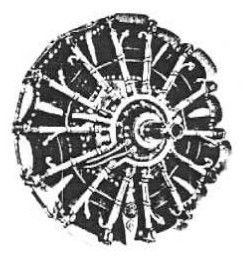
"Elizalde Sirio S-2"
-According to the chronicles, the Sirius had difficulties for its set-up and did not arrive in time to mount on the mentioned airplanes. Even a series of 400 engines was canceled.
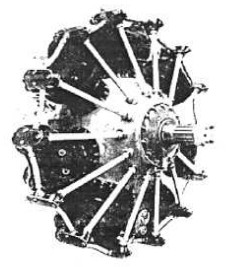
"Sirio S-VII"
-In 1952 the Elizalde Factory becomes part of the INI (National Institute of Industry), changing its name to ENMASA: Empresa Nacional de Motores de Aviación SA.
-At that time, they started to work on the "Flecha" and "Alción" engines.
-The "Tigres", "Syrios" and "Betas" were modernized.
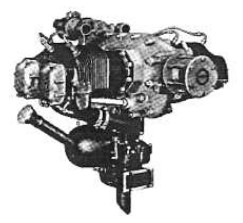
"Flecha"
-The "Flecha" was an engine with 4 horizontally-opposed cylinders, very similar to the Continental C-90.
-Its power that was 90 to 95 CV (93 CV) gave it even more similarity. And also by the form, especially for the oil tank of the same type (for example, in the Arrow Mod. F-IV-1).
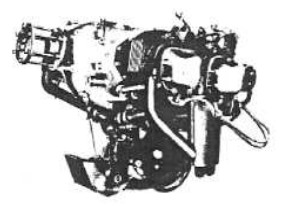
"Flecha"
-The 275 CV "Alción", a 7-cylinder radial, with the propeller governor between the two lower cylinders, and the magnetos and the carburetor at the rear.
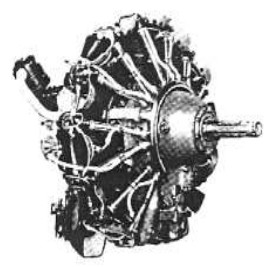
"Alción"
-With destiny to the CASA Hawk (the Sirio was to go to the Alcotán), they did not get to be constructed in important amounts, due to the arrival of American material through the program of loans and lease by the joint air bases installed in Spain.
-Undoubtedly, it was better material and could be considered "gifted".
-The factory acquired the production license for the "Marboré II" turboshafts that delivered 400 Kgs. of thrust, and also for the "Artouste-I" and "-II", of 280 CV and 400 CV respectively, from French Turbomeca. These engines were destined to the HA -200 Saeta and the Aerotécnia AC-13 and AC-14 helicopters.
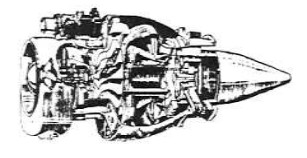
"Marboré II"
-From Paseo de San Juan, between 1958 and 1959, the factory was moved to the industrial district of Sant Andreu (next to the facilities -also moved- of the company "Maquinista Terrestre y Marítima") where at that same time Mercedes-Benz industrial vehicles were built and "Aries" 4-cylinder industrial engines that were cooled by forced air, which are mainly seen in public works.
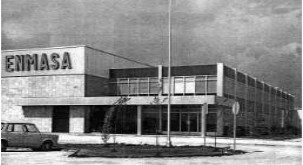
"New facilities"
-ENMASA installed new workshops in Alcalá de Henares to review turbojets, which was the beginning of the dismantling in Barcelona and the transfer to Madrid, being definitively consummated in 1969. Tools, documentation, etc.
-As from 1971, the new facilities in Ajalvir were added to the means of Alcalá de Henares and a year later it was merged as the engines division of CASA. Only engines were reviewed and today it is ITP (see).
-Elizalde together with Hispano Suiza, born precisely in Barcelona (in La Sagrera), made this city a leader in aeronautical engineering. Great technicians and engineers were trained. They had excellent apprentice schools and metallurgical laboratories.
-It had a technical cadre of highly qualified and prestigious personnel.
-As we will see, Hispano Suiza was absorbed by ENASA and eventually it ended up in Madrid as well.
Engines of ELIZALDE
Model: 18W, 650 (proyecto)
Arquitecture:
Cooling:
Total Displacement:
Bore / Stroke:
Power:
Weight:
Model: Alción, 7 cyl. radial, 275 CV
Arquitecture: 4-stroke7-cylinder Radial
Cooling:
Total Displacement:
Bore / Stroke:
Power: 275 CV
Weight:

"Elizalde Alción"
Model: Atalante”, 18W, 1000 CV, proyecto
Arquitecture:
Cooling:
Total Displacement:
Bore / Stroke: x
Power:
Weight:
Model: Beta, 9 cyl, radial
Arquitecture: 9-cylinder Radial
Cooling: Air
Total Displacement:
Bore / Stroke:
Power: 750 CV
Weight:

"Elizalde Beta cutaway"
Model: Dragon IX, 9 cyl. radial
Arquitecture: 9-cylinder Radial
Cooling: Air
Total Displacement:
Bore / Stroke:
Power: 420 CV
Weight: 340 Kg

"Elizalde Dragon IX"
Model: Dragon V, 5 cyl. radial
Arquitecture: 5-cylinder Radial
Cooling:
Total Displacement:
Bore / Stroke:
Power: 172 CV @ rpm
Weight:

"Elizalde Dragón V"
Model: Dragon VII, 7 cyl. radial
Arquitecture: 7-cylinder Radial
Cooling:
Total Displacement:
Bore / Stroke:
Power: 320 CV @ 1800 rpm
Weight:

"Elizalde Dragon VII"
Model: Flecha, 4 cyl. boxer, 95 CV
Arquitecture: 4-stroke4-cylinder Horizontally opposed
Cooling: Air
Total Displacement:
Bore / Stroke:
Power: 95 CV
Weight:

"Elizalde Flecha"
Model: J-4, 110 HP (Walter Mikron, Lic.)
Arquitecture: 4-cylinder In line inverted
Cooling: Air
Total Displacement:
Bore / Stroke:
Power: 105 CV
Weight:
Model: M-21 (Turbomeca Marboré II, Lic)
Arquitecture: Turbojet
Compressor/s: Single stage centrifugal
Combustion chambers: 1 annular combustion chamber
Turbines: Single stage
Power / Thrust: --- / 400 Kgf
Weight:

"Elizalde Marboré II"
Model: Sirio, 7 cyl. radial, 500 CV
Arquitecture: 7-cylinder Radial
Cooling:
Total Displacement:
Bore / Stroke:
Power: 500 CV @ 2130 rpm
Weight:

"Elizalde Sirio S-VII"
Model: Super Dragon, 9 cyl. radial
Arquitecture: 9-cylinder Radial
Cooling:
Total Displacement:
Bore / Stroke:
Power: 525 CV
Weight:

"Elizalde Super-Dragon"
Model: T-41 (T-40), 6 en linea, 100 CV
Arquitecture: In-line
Cooling: Air
Total Displacement:
Bore / Stroke:
Power: 100 CV
Weight:
Model: T-80, V-8, 150 CV
Arquitecture: 8-cylinder V-Engine
Cooling: Liquid
Total Displacement:
Bore / Stroke:
Power: 150 CV @ 2000 rpm
Weight:
Model: Tigre G-IV-B, 4 cyl. inline, 150 CV
Arquitecture: 4-stroke4-cylinder In line inverted
Cooling: Air
Total Displacement: 6.3 Ltr.
Bore / Stroke: 120 x 140 mm
Power: 150 CV @ 2500 rpm
Weight:
Model: Tigre G-IVA, 4 cyl. inline, 125 CV
Arquitecture: 4-stroke4-cylinder In line inverted
Cooling: Air
Total Displacement: 6.3 Ltr.
Bore / Stroke: 120 x 140 mm
Power: 125 CV @ 2200 rpm
Weight: 120 Kg

"Elizalde G-IVA-5 with TM"
Model: Tigre G5
Arquitecture:
Cooling:
Total Displacement:
Bore / Stroke: x
Power:
Weight:
Model: Tigre VI, proyecto
Arquitecture: 6-cylinder In line inverted
Cooling:
Total Displacement:
Bore / Stroke:
Power:
Weight:
Model: Tigre VIII, proyecto
Arquitecture: 8-cylinder V-Engine
Cooling:
Total Displacement:
Bore / Stroke:
Power:
Weight:
Model: Tigre XII, proyecto
Arquitecture: 12-cylinder V-Engine
Cooling:
Total Displacement:
Bore / Stroke:
Power:
Weight:
Model: Tipo A-3, Lorraine 12 Eb (Lic.)
Arquitecture: 4-stroke W-engine
Cooling: Liquid
Total Displacement: 24.4 Ltr.
Bore / Stroke: 120 x 180 mm
Power: 450 CV @ 2000 rpm
Weight:

"Elizalde A-3"
Model: Tipo A-4 (Lorraine up-rated)
Arquitecture: 4-stroke12-cylinder W-engine
Cooling: Liquid
Total Displacement: 24.4 Ltr.
Bore / Stroke: 120 x 180 mm
Power: 450 CV @ 2500 rpm
Weight:
Model: Tipo A-5 (Lorraine mejorado y up-rated)
Arquitecture: 4-stroke12-cylinder W-engine
Cooling: Liquid
Total Displacement: 24.4 Ltr.
Bore / Stroke: 120 x 180 mm
Power: 480 CV @ 1850 rpm
Weight:
A4 with gear.
Model: Tipo A-6, 5 cyl. radial, 120 CV
Arquitecture: 5-cylinder Radial
Cooling: Air
Total Displacement:
Bore / Stroke:
Power: 120 CV
Weight:


